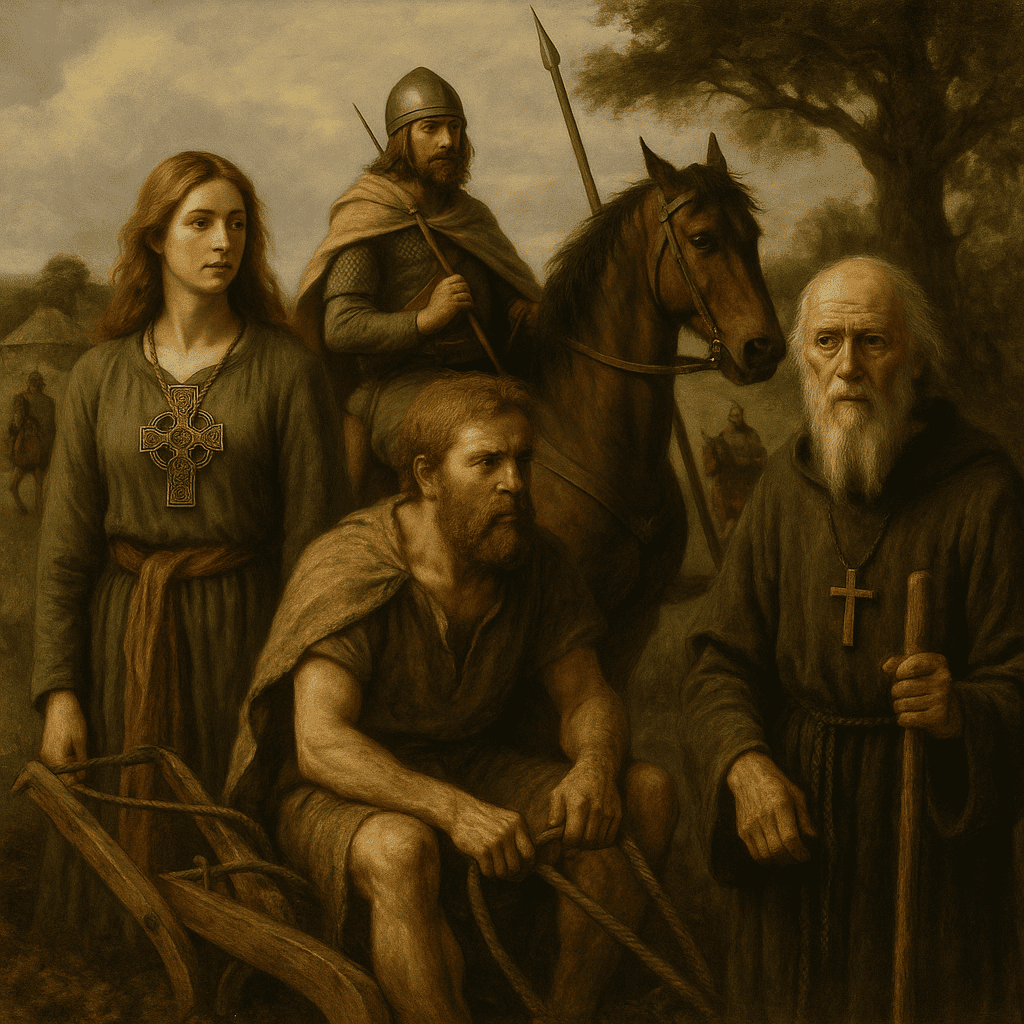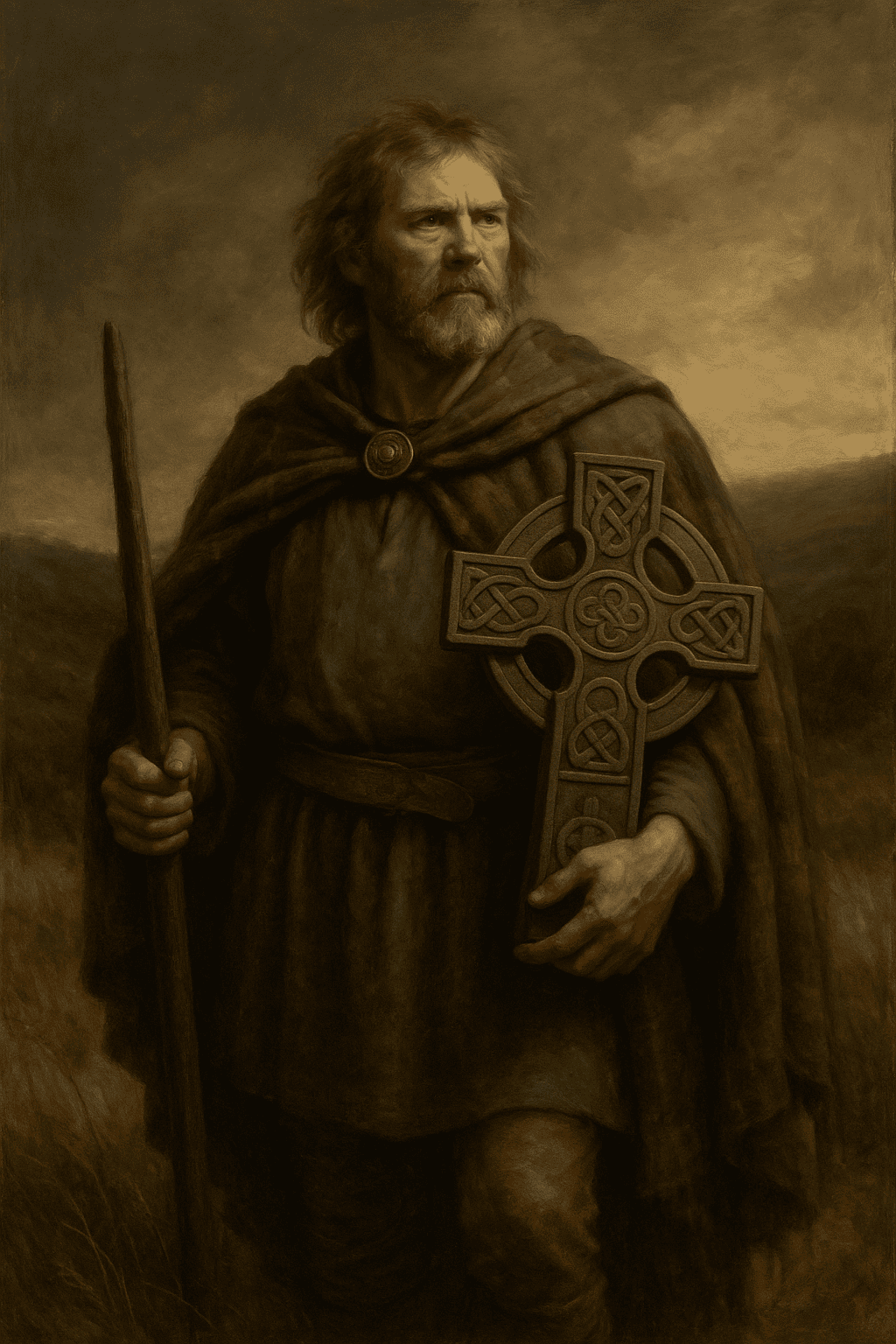
Here, centuries do not replace one another; they settle in layers, like pages in a book where every chapter continues the same story.
Myths become chronicles, heroes turn into saints, and symbols are stitched into the very fabric of the land.
And within this endless weave, Ireland has kept one truth:
everything created with soul never dies — it merely changes form.
The Origins That Never Fade
Long before cathedrals and kingdoms, Ireland was a land of craft and light.
Early settlers spun wool between damp palms, twisting it into strong, breathing threads.
Flax grew on misty plains; it was pulled, soaked, and beaten until it shone like water under the sun.
From it came the first fabric — coarse, warm, and alive with the scent of rain and earth.
Deer and ox hides were tanned with oak bark and moss, softened by salt wind and smoke.
From these, craftsmen made bróg shoes, belts, pouches, and armor — each piece shaped by patient hands, each carrying the maker’s quiet mark.
They did not sign their work, but their touch outlived them.
Poets, Warriors, and the Fabric of Honor
Later came the Celts, who brought not only bronze and iron, but also the art of form.
They saw the world as a living pattern — every spiral a path between life and death.
For them, craft was prayer, and making was remembering.
A weaver spinning threads and a poet spinning words were kin: one worked with wool, the other with meaning. The tales of the Ulster Cycle and the Fianna are not simply myths; they are the loom of Irish memory.
Cú Chulainn, hero of light and rage, fought not for glory but for truth.
Fionn mac Cumhaill, leader of the Fianna, was both warrior and poet — proof that strength and imagination were never meant to be apart.

The Cross in the Sun
When Christianity reached the island, it did not erase the old ways — it wove itself into them. The druids’ wisdom became the monks’ scripture. Early monks wore wool robes spun by the same women who had clothed kings and farmers alike.
They wove altar cloths from linen and painted the same spirals into holy manuscripts that once decorated swords and shields.
From this union was born the Irish High Cross — not a symbol of pain, but of balance.
The circle was the sun, the vertical line the spirit, and the horizontal the earth.
Together they formed a map of the universe — the eternal rhythm of creation.
The Values That Survived Kingdoms
When empires fell and languages were forbidden, Ireland was saved by three crafts: weaving, storytelling, and memory.
Women in Donegal and Clare kept spinning wool, dyeing it with roots, lichens, and iron water. Men carved crosses from stone so that the old designs would never vanish.And poets — the filí — spoke aloud what the land could not say itself.
They knew that to lose a story was to lose a piece of the soul.
The Art of Fabric as Prayer
The finest Irish garments were not made for show but for endurance. Every step of the process was sacred: shearing sheep in spring, washing the wool in cold rivers, spinning by the fire, dyeing with plants, weaving slowly — and only then, sewing. Flax for monasteries was grown in humble fields, where water pooled after rain.
From it came not only robes but the pages of the Book of Kells, where words and art merged into one act of devotion.
Even silk, rare and precious, was interlaced with wool to remind believers that faith, like fabric, must stay warm.
Memory Through Faith
When the monks illuminated their manuscripts under candlelight, they were not just copying words — they were re-weaving the world.
The Celtic knot and the Book of Kells are not decoration; they are motion frozen in light, a map of eternity.
Each curve leads back to its beginning, like breath returning to the lungs of time.
That is why nothing in Ireland truly vanishes — it only shifts shape.
A pattern becomes a prayer, a myth becomes a melody, a cross becomes a story for children learning who they are.
Traditions That Still Breathe
Today, on the Aran Islands, women knit sweaters whose stitches tell family histories — diamonds for prosperity, cables for safety at sea.
In Donegal, weavers still create the legendary Donegal tweed, flecked with color like sunlight through mist.
In craft schools of Clare and Kerry, leatherworkers still tan hides with bark and tea, teaching patience through the rhythm of the hands.
In Galway, the Irish language — Gaeilge — fills the air again, carrying ancient words like anam (soul) and talamh (earth), which sound almost the same, as if reminding us that the two are one.
These crafts are not nostalgia — they are continuity.
To make something well is still to honor life itself.
The Circle That Never Breaks
In Celtic design there is no beginning and no end — only flow.
So too with Ireland: it does not simply remember; it breathes memory.
Its stone crosses are not monuments but portals — places where past and present meet like dawn touching mist.
Every Aran sweater, every song, every carving is a thread that ties us to those who came before.
When you look at a cross woven with the sun, you are not seeing just a symbol.
You are seeing the hands of weavers, monks, and poets — generations who never stopped believing that creation itself is sacred.
Ireland is not a place; it is a thread that refuses to break, stretching from sheep’s wool to digital screens, still carrying the scent of rain.
